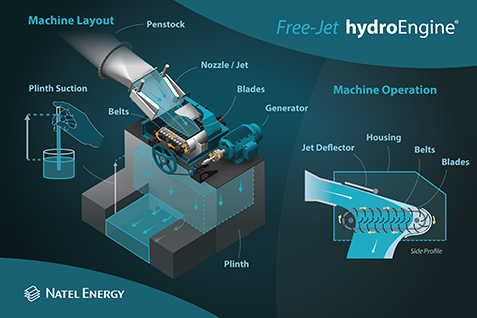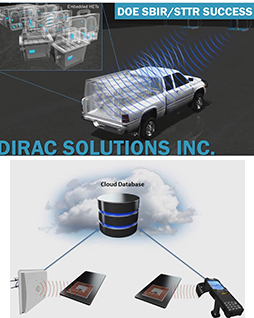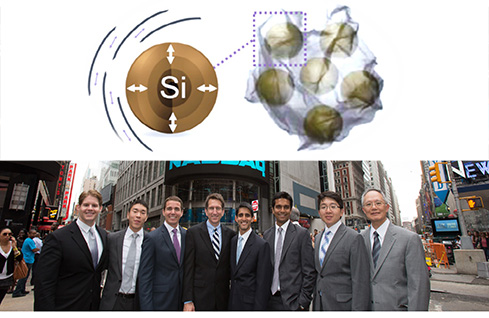Innovative Hydropower Turbines for Low-Cost, Ecosystem-Safe Generation of Electricity
Natel Energy turbine technology makes it possible to tap into the undeveloped hydropower potential at drops between 5 and 20 feet, which is estimated at 70 GW

R&D Opportunity
The U.S. Department of Energy (DOE) aims to double hydropower generation in the United States by 2030. To do so, DOE is investing in developing technologies that will dramatically change the concept of hydropower by lowering costs, improving performance, and preserving the environment.
Typical hydropower plants involving big dams with head drops of hundreds of meters are very expensive because they require civil work, far beyond what the common observer can see. This engineering is necessary to prevent the phenomenon of cavitation. When water falls down from a tall dam, its pressure is very high because of its high potential energy. The water pressure changes dramatically as the water contacts the fast-moving turbine blades. Sometimes, the water’s pressure can locally fall below the water’s vapor pressure causing bubbles that subsequently implode and release powerful and damaging shock waves.
To avoid cavitation in conventional hydropower plants, the water static pressure needs to be increased by encasing the turbine in a chamber dag below the riverbed. The construction of such encasing spaces, which need to be kept dry, is a very expensive proposition. In addition, stopping the river flow with a big dam negatively affects the entire ecosystem upstream.
Solution
Natel Energy turbines represent one of the ways to lower costs, improve performance, and preserve the environment. The Natel Energy turbines mimic a natural analog—beavers. Natel Energy’s turbines produce electricity using a cascade of smaller dams with low head drops, similar to beavers’ dams, as opposed to one big dam. The low head installations restore wetlands and slow the rate of water runoff, which is very important for mitigating floods, especially out west.
Natel Energy’s turbines are different from turbines used in conventional hydropower plants. They do not require high pressure, which means the head can be much smaller. Also, the turbines operate at constant water pressure, which eliminates the cavitation problem. Because the civil construction costs are so much lower than for big dams, these turbines can be installed in numerous small structures. These structures take advantage of natural river landscapes, without disrupting the ecosystem.
To work in the real world, the turbines need to be very efficient and produce enough energy to make the installations cost effective. Because the power a turbine can produce is given by pressure ´ flow, operating at low pressures requires a very large flow. The large flow is handled by eliminating the architectural limitation of having a single rotor shaft. A conventional turbine, no matter what the specific design, is made of blades arranged around a rod-like shaft. If we think about stretching this design so that the rod resembles a conveyor belt, we increase the cross section of fluid the turbine can accommodate and therefore the flow, similar to the concept of adopting a bigger sail to make a sailboat go faster. This idea is at the core of Natel Energy’s innovative turbine technology.
Impact
Natel Energy was founded by two siblings: Abe Schneider, Chief Technology Officer, and Gia Schneider, Chief Executive Officer, in 2009. Soon after, Natel Energy received a DOE Small Business Innovation Research (SBIR) award. The award was funded by the Wind and Water Power Program within the Office of Energy Efficiency and Renewable Energy (EERE). Natel Energy used the Phase I and Phase II SBIR funds to fully develop aspects of their prototype. At the end of their Phase II SBIR award in 2012, their technology had advanced sufficiently for them to raise nearly $10 million of private capital from three billion-dollar family investment firms. Using these funds, Natel Energy has transferred operations to a large facility in the former Alameda Naval Air Station in the San Francisco Bay Area.
After the DOE Phase II SBIR, Natel Energy further pursued product innovation guided by new technical insights and motivated by the market-dictated necessity to increase turbine efficiency and lower costs. Natel Energy has already transitioned to a more advanced prototype than the one developed under the SBIR award. The new prototype, the Free-jet hydroEngine® was developed following Abe Schneider’s insight that by changing the shape of the blades, the powertrain could be arbitrarily extended. The result is a turbine that operates in an open flow of water. The turbine does not need to be enclosed in a structure where the flow is directed inside a pipe. This insight has brought down the amount of building material needed by 50% while boosting turbine efficiency.
The new prototype is currently under continuous testing, operated by a new recirculating hydraulic testing set-up. Single parts, like the conveyor belt reinforced by carbon fibers and innovative bearings made to withstand years of continuous sheer forces, are tested in harder environments. The single parts are subjected to a force of 50 tons and in contact with acid water containing grit and dirt.
Natel Energy has developed a clear plan for addressing the entire U.S. chain. They’ve engaged critical suppliers from various U.S. states. The work is going to focus primarily on assembly, including continuous prototype development, de-risking, and testing.
In summary, Natel Energy has developed a clear path forward and is leveraging current private investments to de-risk their second-generation prototype. The company is setting up for production-scale manufacturing.
Contact
Gia Schneider, CTO, Natel Energy
gia@natelenergy.com, www.natelenergy.com
Highlight written by Claudia Cantoni, DOE SBIR/STTR, claudia.cantoni@science.doe.com
Highlight Categories
Program: EERE



